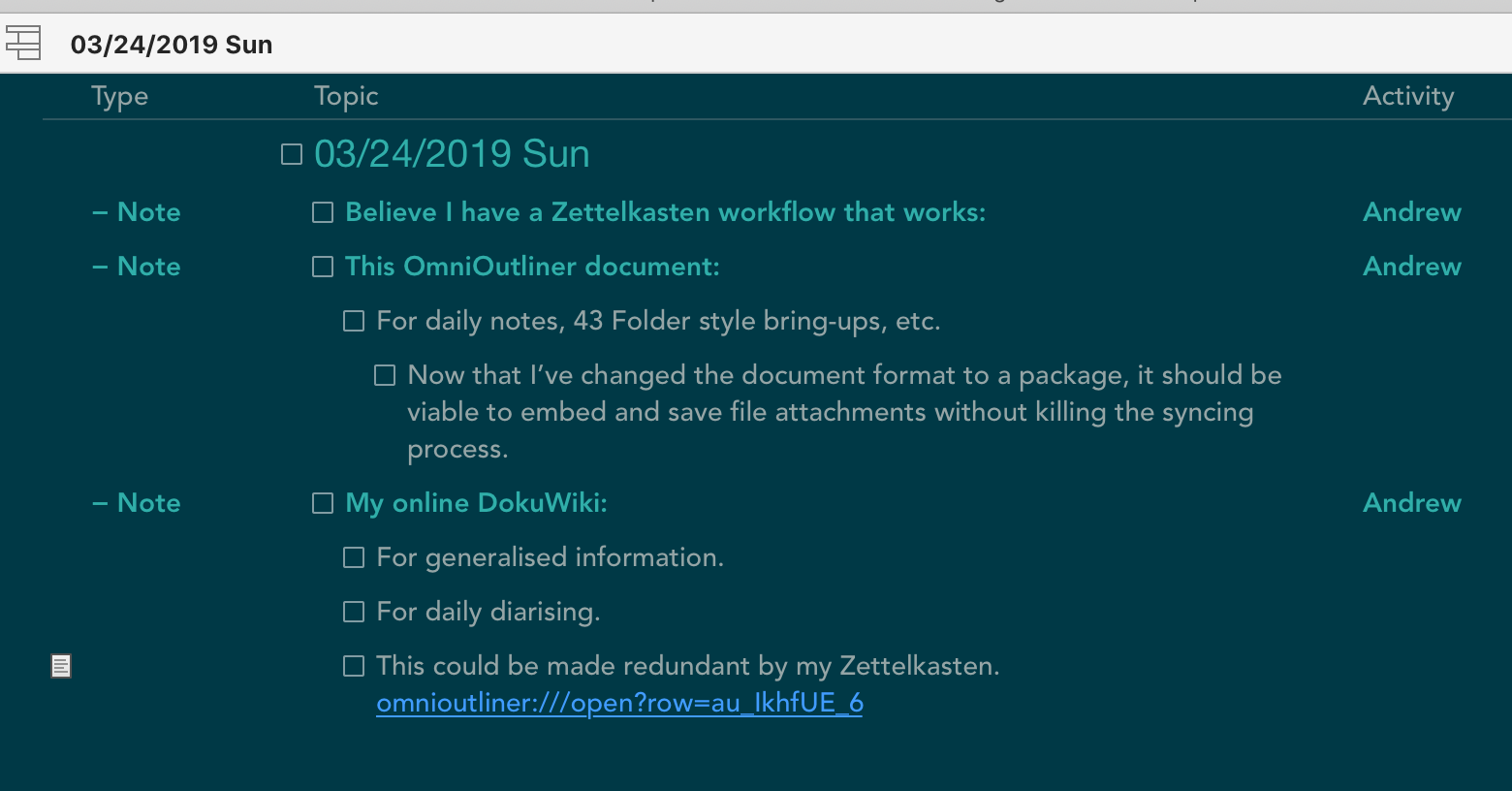OmniOutliner as a Daybook
I’ve recently taken to using OmniOutliner as a daybook/Bullet Journal. I don’t actively follow the bullet journal methodology, although the more I think about it, the more useful it seems.1
Traditionally, I’ve not been one to record daily events as they occur and make notes about all the little things. More recently, however, I’m finding that I want to recall something that happened earlier, or a decision that was made, or an event. Whether this is memory loss caused by ageing, or wisdom gained through experience, I’m not sure. Whatever the reason, I know I want to keep some sort of minimal journal.
This journal needs to be separate and different from my task list. Nor do I want it to be my knowledge archive/zettelkasten. Those are different things that need different treatment. How I take care of those things is a story for another day.
OmniOutliner
I’ve owned copies of OmniOutliner Professional for the longest time but haven’t ever made full use of it. It has always presented itself as too fiddly. The fact that it’s not that great at exporting has been a problem as well, in that I put a bunch of stuff in, but have trouble exporting it to a format that works for others.
For this purpose, however, OmniOutliner seems very well suited. This data doesn’t need to go any further than me.
Getting Started (With a Little Help From My Friends)
Steve Zeoli from Welcome to Sherwood was kind enough to kickstart my project by sending me a text file that has an outline of every day and date of the year. This was my starting point. Pasting this into OmniOutliner gave me a basic outline.
Now, within each day, I can nest commentary and notes. Just little tidbits and things I might need to know or refer back to. I can use it as a 43 Folders style bring-up system, nesting attachments or notes within the day they will be needed. I’ve done this with my tickets for EPW Goldrush2.
 A sample entry from my OmniOutliner Daybook
A sample entry from my OmniOutliner Daybook
OmniOutliner syncs across macOS and iOS using its own OmniPresence sync server. While I would prefer if it worked natively with iCloud Drive, in reality it doesn’t really matter.
OmniOutliner allows for multiple columns, so I have been able to create a few ‘metadata’ columns to support my notes. I’m still experimenting here, but at the time of writing, I’ve got pop-up selectors for Type (task, note, event), Activity (major project areas) and Context (action, waiting). While not wanting to replicate a task manager, having a few bits of extra data allows me to leverage the real power of OmniOutliner, which is filtering and focusing.
Filtering & Focusing
Using OmniOutliner, I can focus on just a single day, hiding all other 364 days. Or I can focus on the upcoming month. Or a selection of non-contiguous days.
Furthermore, I can filter based on the criteria of the columns. So if I just want to see the lines I have tagged the note to be an action, I can do that. Or I can combine the filtering and focusing to show me events in the next month. It’s all quite fun.
What’s more, all this filtering and focusing can be done on both platforms: iOS is an equal citizen with macOS.
Hot Tip: Change the File Format to a Bundle
If you are planning to keep a number of file attachments within your OmniOutliner document, and sync them efficiently, I highly recommend changing the default file save format. By default it saves as a ‘flat file’ which works better for non-OmniPresence syncing. But this means that each minor save results in the entire file - and attachments - being re-saved and re-synced. This is not very efficient.
Changing to the ‘bundle’ format allows the app to save using the macOS package file format. This then only syncs the changed elements, and leaves the various file attachments untouched and so they don’t sync each time.
Other Options
There are plenty of options available to do a similar job, and I’ve tried them all!
With Steve’s date file, it was easy to try incorporating it into each application. They all have strengths and weaknesses, of course.
Some of these include:
- TheBrain - really fun software to use, but it was a resource hog on my laptop and it’s just too expensive (both initially and then a subscription) when I already own viable alternatives.
- DEVONthink - this can do the job, but it’s just too clunky for continuous quick text entry.
- Notebooks - I couldn’t find a nice way to integrate this app for this purpose.
- Paper & Pen - I’m a tech-addict!
I am sure my use of this daybook will ebb and flow, and I will probably change my approach as time goes on.
However, I can say that this system has made quick logging of events and noteworthy items doable through the day, and I believe I will get value back from it over time.